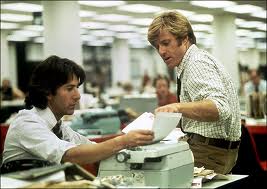sr772610@ohio.edu
The Modern Age of Journalism
College dorm rooms are not decorated with posters of the heroes of journalism. The walls are painted with the likes of Kobe Bryant, Miami Dolphin cheerleaders and a game of six-cup beer pong. Ohio University is renowned for its journalism school, yet the students do not share appreciation and admiration for the hard-workers leading the profession.
In fact, if journalism needed a face to figurehead integrity, ethics and the core values of journalism, the most recognized faces would be Robert Redford or Dustin Hoffman from the movie All The President’s Men. Where are the mentors and heroes leading the industry? The only current household names are infamous and subject to discussion of heroism, like Edward Snowden. Cases like Snowden elicit the discussion of the modern age of journalism—whether to bar or open the door for transparency.
College dorm rooms are not decorated with posters of the heroes of journalism. The walls are painted with the likes of Kobe Bryant, Miami Dolphin cheerleaders and a game of six-cup beer pong. Ohio University is renowned for its journalism school, yet the students do not share appreciation and admiration for the hard-workers leading the profession.
In fact, if journalism needed a face to figurehead integrity, ethics and the core values of journalism, the most recognized faces would be Robert Redford or Dustin Hoffman from the movie All The President’s Men. Where are the mentors and heroes leading the industry? The only current household names are infamous and subject to discussion of heroism, like Edward Snowden. Cases like Snowden elicit the discussion of the modern age of journalism—whether to bar or open the door for transparency.
Transparency and Getting the Job Done
Newsbreaks are instantaneous. When headlines are read on Twitter feeds instead of the next day’s paper, word travels faster, and the journalistic dilemmas are forefront -- prevalent like a grammar technician correcting misspellings on the timeline. Click on a link to a story from the large circulation newspapers. At the bottom of the page, the comment section directly allows questions of article. On this opinion editorial from The New York Times on the ongoing situation in Syria, commenters rant in few hundred-word paragraphs, either agreeing, disagreeing or questioning the article.
The comment section allows for reader involvement and demands fact checking. It’s a rather genius inclusion into the online articles. Rather than face bombardments of letters to the editor, most readers speak their peace online. It holds the writers to a degree of honesty and accountability, although what most opinionated viewers would like is a glimpse into the creation process of the day’s newspaper. According to the article, “Too Transparent,” by Rachel Smolkin at the American Journalistic Review, in Spokane, Washington, the Spokane-Review holds open newsroom meetings, allowing the public entry—a very regulatory concept.
The debate for levels of transparency begins and ends with the discussion of impunity. Should journalists be reviewed and critiqued in the same manner journalists review and critique other businesses worthy of news? Mostly everyone will agree the need to regulate newsrooms and papers for ethical reasons. However, review, questioning and fact checking can become a hindrance to silent sources, sensationalism and popularized circulation. Only the highest quality of papers and journalists will use a comment section to its potential -- to allow discussion and comment on the reporting of the paper. Only a few newsrooms will open to the public.
Newsbreaks are instantaneous. When headlines are read on Twitter feeds instead of the next day’s paper, word travels faster, and the journalistic dilemmas are forefront -- prevalent like a grammar technician correcting misspellings on the timeline. Click on a link to a story from the large circulation newspapers. At the bottom of the page, the comment section directly allows questions of article. On this opinion editorial from The New York Times on the ongoing situation in Syria, commenters rant in few hundred-word paragraphs, either agreeing, disagreeing or questioning the article.
The comment section allows for reader involvement and demands fact checking. It’s a rather genius inclusion into the online articles. Rather than face bombardments of letters to the editor, most readers speak their peace online. It holds the writers to a degree of honesty and accountability, although what most opinionated viewers would like is a glimpse into the creation process of the day’s newspaper. According to the article, “Too Transparent,” by Rachel Smolkin at the American Journalistic Review, in Spokane, Washington, the Spokane-Review holds open newsroom meetings, allowing the public entry—a very regulatory concept.
The debate for levels of transparency begins and ends with the discussion of impunity. Should journalists be reviewed and critiqued in the same manner journalists review and critique other businesses worthy of news? Mostly everyone will agree the need to regulate newsrooms and papers for ethical reasons. However, review, questioning and fact checking can become a hindrance to silent sources, sensationalism and popularized circulation. Only the highest quality of papers and journalists will use a comment section to its potential -- to allow discussion and comment on the reporting of the paper. Only a few newsrooms will open to the public.
Where Will the Future Lead
The article
by Craig Silverman “Journalism’s
Summer of Sin marked by plagiarism, fabrication, obfuscation,” shows the
hypocrisy of a closed door policy of papers, “If we in the press stonewall and
hide behind vague public statements when ethical breaches happen within our
ranks, then we embolden politicians and other public figures and sources to do
the same.” Openness to questions of
policy, reporting, editing and circulation provide a paper immune to
ethical dilemmas, a better resolution than impunity.
If I were
an editor, I’d reformat the newsroom. I'd take out any cubicles and face the world. Remove any certainty of doubt by providing
strict rules of ethics and a process for the evaluation of ethics. Someday, the walls in a college dorm might
have a poster or two of the next All the
President’s Men.

No comments:
Post a Comment